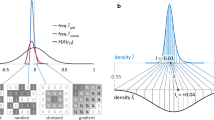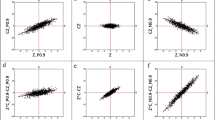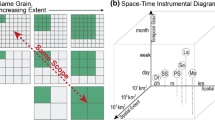Abstract
Context
Interpreting spatial autocorrelation is complicated by differences in data type, spatial conformation, and contiguity definitions. Though lacking consistent meaning, Moran’s I is commonly reported, compared, and interpreted based on conceptual ideals. To provide consistent, logical, and intuitive meaning and enable broader synthetic work, a new approach to I is needed.
Objectives
We sought to standardize I and true it to conceptual ideals and existing intuition regarding regular correlations. We also wished to test performance of transformed metrics over a diversity of designed and empirical datasets.
Methods
We developed two means to rectify I. Both fit null distributions from data permutation to a target frame of [− 1, 0, 1], followed by projection of original I into this conformation. One method used three-point registration employing the distribution median and select tail percentiles. The other directly projected all I based on theory or cumulative frequencies reflecting the distribution of regular correlations. Repeatability and sensitivity of results were examined for varied permutation replication and framing parameter choices. Empirical and designed datasets were used to compare rectified to traditional metrics.
Results
Both rectification methods improved distributional characteristics of I. Three-point registration produced overly broad distributions with discontinuous peaks. Continuous projection fit the distribution for regular correlations precisely. Diverse case studies demonstrated failings of I and the clarity gained by rectification.
Conclusions
Rectified I enabled meaningful comparisons of spatial patterns for diverse data and landscape conditions. Preserving the intuitive value of Moran’s I while providing a theoretically sound and consistent approach for standardizing its values should foster sustained use.











Similar content being viewed by others
References
Anselin L (1988) Spatial econometrics: methods and models. Kluwer, Dordrecht
Anselin L (1995) Local indicators of spatial association—LISA. Geogr Anal 27:93–115
Chen Y (2013) New approaches for calculating Moran’s index of spatial autocorrelation. PLoS ONE 8:e68336
Cliff AD, Ord JK (1969) The problem of spatial autocorrelation. In: Scott AJ (ed) Studies in regional science, vol 1. Pion, London, pp 25–55
Cliff AD, Ord JK (1973) Spatial autocorrelation. Pion, London
Cliff AD, Ord JK (1981) Spatial processes: models & applications. Pion, London
Cozzarolo CS, Jenkins T, Toews DPL, Brelsford A, Christe P (2018) Prevalence and diversity of haemosporidian parasites in the yellow-rumped warbler hybrid zone. Ecol Evol 8:9834–9847
D’agostino RB, Belanger A, D’agostino RB Jr (1990) A suggestion for using powerful and informative tests of normality. Am Stat 44(4):316–321
de Jong P, Sprenger C, van Veen F (1984) On extreme values of Moran’s I and Geary’s c. Geogr Anal 16:17–24
DeWitt TJ (2016) Expanding the phenotypic plasticity paradigm to broader views of trait space and ecological function. Curr Zool 62:463–473
Dokmanic I, Parhizkar R, Ranieri J, Vetterli M (2015) Euclidean distance matrices: essential theory, algorithms, and applications. IEEE Signal Process Mag 32:12–30
Durbin J, Watson GS (1950) Testing for serial correlation in least squares regression. Biometrika 37:409–428
Fortin M, Dale M (2005) Spatial analysis: a guide for ecologists. Cambridge University Press, New York
Fuentes JI, DeWitt TJ, Ioerger TR, Bishop MB (2020) Irescale: calculate and rectify Moran’s I. R package v. 2.3.0. https://cran.r-project.org/package=Irescale. Accessed 10 Dec 2020
Getis A (2010) Spatial autocorrelation. In: Fischer MM, Getis A (eds) Handbook of applied spatial analysis: software tools, methods and applications. Springer, Heidelberg
Goldsmith GR, Allen ST, Braun S, Engbersen N, González-Quijano CR, Kirchner JW, Siegwolf RTW (2019) Spatial variation in throughfall, soil, and plant water isotopes in a temperate forest. Ecohydrology 12:e2059
Goodchild MF (1988) Spatial autocorrelation. Concepts and techniques in modern geography. Geobooks, Norwich
Greenwood JD (2015) A conceptual history of psychology: exploring the tangled web. Cambridge University Press, New York
Griffith DA (1987) Spatial autocorrelation: a primer. Association of American Geographers, Resource Publications in Geography, Washington DC
Hotelling H (1953) New light on the correlation coefficient and its transforms. J R Stat Soc B 15:193–232
Hurley JR, Cattell RB (1962) The procrustes program: producing direct rotation to test a hypothesized factor structure. Behav Sci 7:258–262
L’Herpiniere KL, O’Neill LG, Russell AF, Duursma DE, Griffith SC (2019) Unscrambling variation in avian eggshell colour and patterning in a continent-wide study. R Soc Open Sci 6:181269
Kim D, DeWitt TJ, Costa CSB, Kupfer JA, McEwan RW, Stallins JA (2015) Beyond bivariate correlations: three-block partial least squares illustrated with vegetation, soil, and topography. Ecosphere 6:135
Li H, Calder CA, Cressie N (2007) Beyond Moran’s I: Testing for spatial dependence based on the spatial autoregressive model. Geogr Anal 39:357–375
Mantel N (1967) The detection of disease clustering and a generalized regression approach. Cancer Res 27:209–220
Marrot P, Garant D, Charmantier A (2015) Spatial autocorrelation in fitness affects the estimation of natural selection in the wild. Methods Ecol Evol 6:1474–1483
Möller AP, Jennions MD (2002) How much variance can be explained by ecologists and evolutionary biologist? Oecologia 132:492–500
Moran PAP (1947) Some theorems on time series. Biometrika 34:281–291
Moran PAP (1950) Notes on continuous stochastic phenomena. Biometrika 37:17–23
Mukaka MM (2012) Statistics corner: a guide to appropriate use of correlation coefficient in medical research. Malawi Med J 24:69–71
Pearson K (1924) Historical note on the origin of the normal curve of errors. Biometrika 16:402–404
Rahman NA (1968) A course in theoretical statistics. Charles Griffin and Company, Glasgow
Ritters K (2019) Pattern metrics for a transdisciplinary landscape ecology. Landsc Ecol 34:2057–2063
Rogerson PA (1999) The detection of clusters using a spatial version of the chi-square goodness-of-fit statistic. Geogr Anal 31:130–147
Rohlf FJ, Sokal RR (1995) Statistical tables. Macmillan, New York
Rosenthal R, Rubin DB (1986) Meta-analytic procedures for combining studies with multiple effect sizes. Psychol Bull 99:400–406
Sen A (1976) Large sample-size distribution of statistics used in testing for spatial correlation. Geogr Anal 8:175–184
Sokal RR, Rohlf FJ (1995) Biometry, 3rd edn. WH Freeman, San Francisco
Thirey B, Hickman R (2015) Distribution of Euclidean distances between randomly distributed Gaussian points in n-space. arXiv preprint arXiv:1508.02238. https://arxiv.org/pdf/1508.02238.pdf. Accessed 20 Dec 2020
Tiefelsdorf M (1998) Some practical applications of Moran’s I’s exact conditional distribution. Pap Reg Sci 77:101–129
Tiefelsdorf M, Boots B (1997) A note on the extremities of local Moran’s Iis and their impact on global Moran’s I*. Geogr Anal 29:248–257
Tobler W (1970) A computer movie simulating urban growth in the Detroit region". Econ Geogr 46(Supplement):234–240
Upton GJ, Fingleton B (1985) Spatial data analysis by example, volume 1: Point pattern and quantitative data. Wiley, New York
Waldhör T (1996) The spatial autocorrelation coefficient Moran’s I under heteroscedasticity. Stat Med 15:887–892
Funding
This project was funded by Texas A&M University T3 (Triads for Tranformation) grant to TJD, MPB, and TRI.
Author information
Authors and Affiliations
Corresponding author
Additional information
Publisher's Note
Springer Nature remains neutral with regard to jurisdictional claims in published maps and institutional affiliations.
Supplementary Information
Below is the link to the electronic supplementary material.
Rights and permissions
About this article
Cite this article
DeWitt, T.J., Fuentes, J.I., Ioerger, T.R. et al. Rectifying I: three point and continuous fit of the spatial autocorrelation metric, Moran’s I, to ideal form. Landscape Ecol 36, 2897–2918 (2021). https://doi.org/10.1007/s10980-021-01256-0
Received:
Accepted:
Published:
Issue Date:
DOI: https://doi.org/10.1007/s10980-021-01256-0




